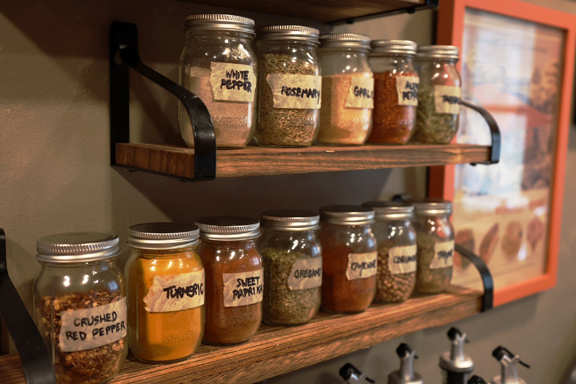Design choices can be emotional when working with a multigenerational home

This image shows a spice rack made with mason jars in a kitchen in Allison Park, Pa. When you live in a multigenerational house, deep-time design opportunities lurk around every corner. Opportunities to blend past and present abound. (AP Photo/Ted Anthony)
ALLISON PARK, Pa. — Should the hanging from Thailand stay on the living-room wall where it has lived since I was born? Should we lay out the family room as it was when I was 8, when I was 17 or in a completely new way? Should we leave my mother’s spice rack on the north wall of the kitchen? What about the spices?
When you live in a house passed down over generations, deep-time design opportunities lurk around every corner. There are so many ways to blend past and present. And the weight of history can rise up and knock you down at the most unexpected moments.
In 2007, we moved into the midcentury modern house that my parents built in 1965 — and that I came home to as a day-old infant in the spring of 1968. It was a split level, and it showed. Upstairs, my mother’s Scandinavian-design sensibilities ruled, with clean lines and blond wood everywhere. Downstairs, my father’s purview, was cluttered with books and framed stamps and record albums and musical instruments.
When my parents left, they moved to a retirement community with some clothes, some furniture, some files, a television and little else. Behind they left 42 years of life’s possessions — things accumulated locally, things gathered during extensive international travels, things we were overjoyed they saved, things everyone agreed should have been thrown out.
It was up to us to add their distinctiveness to our own. But how?

A Thai wall hanging that has been displayed in the same spot since 1965 in the suburban Pittsburgh house built by Ted Anthony's parents is surrounded by items that Anthony and his wife acquired in their own travels. When you live in a home passed down over generations, opportunities to blend past and present abound. (AP Photo/Ted Anthony)
My wife, the one with the finely honed sensibilities, recognized in her kindness that what for her was an act of design was, for me, an encroachment upon good memories. It probably didn’t help that when she did something like moving a stack of bowls from one cabinet to another, she might encounter me in the doorway shouting, “YOU’RE DESTROYING MY CHILDHOOD!” I was joking. Sort of.
Eventually, some decorating patterns emerged. Some were deliberate, others either inadvertent or executed quietly to avoid discord.
• Existing furniture items were replaced with new ones more congruent with our sense of design, but they stayed in the same places. This occasionally lent locations like the living room the sense of an Ikea design showroom, where the layout was exactly the same as decades ago except that, say, the Kibik had suddenly been replaced by the Vallentuna.
• My wife’s increasing proclivity for building industrial-style furniture using stained lumber, metal piping and flanges created an increasingly unified look for the house. But more often than not, many of the items displayed on these spanking-new-but-vintage-looking shelves were carefully curated from my parents’ collection. Best of both worlds.
•
- This image shows a spice rack made with mason jars in a kitchen in Allison Park, Pa. When you live in a multigenerational house, deep-time design opportunities lurk around every corner. Opportunities to blend past and present abound. (AP Photo/Ted Anthony)
- A Thai wall hanging that has been displayed in the same spot since 1965 in the suburban Pittsburgh house built by Ted Anthony’s parents is surrounded by items that Anthony and his wife acquired in their own travels. When you live in a home passed down over generations, opportunities to blend past and present abound. (AP Photo/Ted Anthony)
Ted Anthony, the director of new storytelling and newsroom innovation for The Associated Press, has been writing about American culture since 1990. Follow him on Twitter at http://twitter.com/anthonyted







